Games Mentioned:
- Inversus
- Samurai Gunn
- TowerFall
- Super Monkey Ball
- Pac-Man
- BaraBariBall
Games Mentioned:
 POV: DESIGN. DIFFICULTY 3. LEVEL 2 – 1
POV: DESIGN. DIFFICULTY 3. LEVEL 2 – 1
You’re playing FTL: Faster Than Light. You’ve got powerful lasers and ion cannons and a maxed-out crew. You can teleport a crack squad of Mantis into enemy ships and rip their crew apart at will. You’re ready to take on the final boss. Victory is near. If you mess up, FTL will take all this from you and there’ll be no way of getting it back. Next time you play you’ll have to start over from square one. This is permadeath in a game where state accumulation is critical to success.
Contrast FTL with Super Mario Bros. SMB isn’t recognized as having permadeath, but it does have a hallmark of such a system–if Mario dies with no lives left, the game resets to level 1-1 and the player must start over. No matter how you look at it, dying too much in SMB causes the player to lose progress and have to repeat earlier parts of the game just as it does in FTL.
 (from Explicitly Honest’s review of FTL)
(from Explicitly Honest’s review of FTL)
What FTL has that SMB does not: a surplus of suspended elements and long-enduring resources that the player must continually harness and replenish in order to beat the game. The only elements SMB suspends across levels are power-ups, coins, and lives. FTL has hull HP, weapons, crew members, crew member skill levels, scrap, and ship systems upgrades. The player’s ability to face the game’s challenges is mediated and varied significantly by these suspended elements: can’t shoot without weapons, and can’t fly and fight effectively without crew members and ship systems. All the details the player did to gain access to the powerful weapons and specific ship configuration they’ve been falling in love with can be taken away in the space of just one battle–it’s going to take many playthroughs and many hours of play to be in a similar situation again. In SMB, players can beat the entire game with one life, no power-ups, and no coins. The most profound suspended element in Mario is being able to throw fireballs, the ability granted by picking up the fire flower which appears at the same places in the same levels every time.
The player stands to lose a lot more from dying in FTL than from running out of lives in SMB, yet game design “wisdom” these days dictates that lives are a relic of gaming’s arcade-based past. Design trends tell us to restart the player close to where they died to avoid frustrating the player by wasting their time. Why shouldn’t we apply this design wisdom to FTL and read it the riot act for insufficiently respecting the player’s time and attention? This question brings us to the second distinction in the meaning of permadeath in FTL and SMB: procedural generation.
The player gets to see more content in FTL even if they die and restart the game. The game procedurally generates levels, shops, and encounters so even the first sector can be markedly different between playthroughs. SMB’s levels are pre-configured by the designer, down to tiny details. There aren’t suspended elements that would provide the player with a significant variety of available resources and mechanics that could differ between playthroughs, and there aren’t procedurally generated environments to present different challenges each time. It seems that the complaint addressed by permissive checkpointing and infinite lives is mostly due to players disliking the repetition of stale or easy challenges.
(The preferences of players are multifarious and defy easy categorization, as such the Souls games can pull off high difficulty with a limited checkpointing system much to the delight of a significant population of gamers. Note that the Souls games do not have permadeath: the player will always be shunted back to the most recent checkpoint after dying.)
 (Screenshot from John McCreedy’s article on the game.)
(Screenshot from John McCreedy’s article on the game.)
Procedural generation provides FTL with a diversity of unpredictable details as the player plays through the early stages of the game. The player can pick out common milestones in their progress through the game, like completing each sector, visiting shops, or gaining new crew members, but when those milestones will happen is different each game. The game gains a lot of variety from how its procedurally generated levels change up how the player can build up and expand their ship’s capability in various dimensions, such as weapon effects, special racial abilities for crew members, and access to drone bays and other special ship modules. So even playing through notionally similar challenges over and over across multiple attempts to beat the game doesn’t lead to the kind of staleness that can result from playing the exact same challenges repeatedly as in SMB. Procedural generation significantly widens the space of possible gameplay situations the player will see throughout multiple playthroughs of the game, which allows permadeath to pull its weight as a design feature. The huge state reset upon death hurts the player psychologically nowhere near as much, because they know that next time could hold a significantly different experience in store.
In Republican Dad Mechanics, Austin C. Howe asserts that the bloodstain system in Dark Souls creates a perverse loop where the player will die to some combat encounter and then have to charge back into the same spot of danger to recover their souls, which is likely to just kill them again and cancel those souls forever. He claims this is bad design because it doesn’t reward the player from being diligent and careful, as the rest of the game’s mechanics suggest they should be.
Richard says: First of all, “bloodstain mechanic” is not a mechanic; it belongs in the system / rules category. Normally, I wouldn’t point out such a thing as other critics don’t share the DO system of game element categorization. However, in this article Austin fails to build a coherent argument about Dark Souls, Bloodborne, Metal Gear Rising: Revengeance, and Bayonetta because he tries to compare a system to a mechanic.
“Thus, the game has given me something that should encourage me playing better, that is, the loss of my souls, but it’s also made those things the carrot on a stick that forces me into nonsensical loops of actions.”
The way Austin talks about the effects of dying and going back to collect the souls is vague and unhelpful. He casually argues that dying traditionally encourages players to play better. This is a rule-of-thumb game design phrase that has little substance. It’s more accurate to say that dying is the result of gameplay choices and their consequences. While it’s good to learn from one’s death, dying alone does not encourage players to play better.
Recovering lost souls by returning to the area you die is like a bonus second chance opportunity. Having this opportunity doesn’t force Austin to play a certain way. Repeatedly dying trying to recover lost souls is not nonsensical because the opportunity exists. Going after a bloodstain is only a foolish waste of time if players realize they cannot successfully retrieve what was lost and still attempt to do so. If players skip the opportunity, then their death and respawn is just like other games with traditional save point or checkpoint features. If the player attempts to recover lost souls, the player only stands to lose what he or she collects on the way back to the spot of death.
… for a game as ludically focused as the FromSoft games tend to be, I’m just gonna call it misguided design.
put in mechanics that encourages gamers to more consciously engage with the interactions at hand. But in these cases, we have system upon system built to encourage wild and often unrewarding risk-taking.
I find it odd that Austin shifts the blame of his failures from himself to the game. He described his experience with the bloodstain system as one that often ended in further death and frustration. Later he describes his game experience engaging with Bloodborne’s Rally (Regain health regenerating) system as being “wild” and “unrewarding.” The bottom line is that these games leave the door open for a wide range of applicable player skill and strategic approaches. There’s much more to playing than the simple decision of “do I return to where I died” and the result of “did I retrieve what was lost?” Because most of the outcome is determined by player skill, we cannot say that the game encourages the player to be wild and overly risky. The fact is, the bloodstain system and the Rally system are just rules; rules that should be factored into the players risk reward calculations. Though these systems may change the balance of player choices, the player is ultimately in control.
Talking about this bloodstain system is tricky because it’s a system that ties into level design, modes / features, and difficulty design. With all of that ground to cover, just talking about this one system alone caused Austin to overscope. Unfortunately, Austin seems a bit on tilt with the tone of this article, and he seems too wrapped up in making clever analogies to build an argument.
It would’ve been easy for them to look at player inputting those parries too early and say “git gud scrub” and walk away, but Platinum actually wants people to enjoy their videogames so they don’t do that. Instead, they offer a version of the parry that can be activated much earlier
Here Austin talks about the parry mechanics in Metal Gear Rising: Revengeance and Bayonetta. These are mechanics, not systems. To make an apt comparison, Austin should have compared the parry in Dark Souls or Bloodborne with these games. Focusing on just mechanics would have probably resulted in a much tighter argument.
In the one opportunity Austin has to bring the conversation full circle after overreaching and over-scoping, he blames the fanbase in a particularly crude remark.
How would you implement those kinds of risk-mitigation mechanics in Dark Souls? Well . . . you don’t. Because the fanbase would never shut the f*** up about it.
Teale introduces his concept of relative numbers which are “any number where there aren’t specific absolute values that determine outcomes.” Auction mechanics and victory point race-style rules are common examples.

Mike says: Seems like a really basic concept. Comparing numeric between game elements is foundational to game design. It’s more common than “absolute” numbers. Consider this: the X and Y positions of various things in the 2D space modeled by a game are relative numbers–so that means the core mechanic of movement in 2D action games, platformers, and strategy games is all about relative numbers.
I’m not a fan of the name of the concept. “Relative” to me conjures “+1” or “half”, not the mere fact that two numbers are related to one another by some third rule.
 POV: PLAYER. DIFFICULTY 3. LEVEL 1 – 1
POV: PLAYER. DIFFICULTY 3. LEVEL 1 – 1
Everywhere I go, I always seem to find a design-oriented conversation. This time, I was hanging out with friends in a hotel room at an anime convention. Every year for the last 10+ years, we meet up to play some video games and some board games. This year we played One Night Ultimate Werewolf.
Going into that session, Marcus and I knew next to nothing about this style of game. As is common with board games, the person who brings the game to the group takes up the role of explaining the rules. Meet the guy who brought Werewolf, Chang, the shirtless guy with the green hair. Without much introduction, Chang sucked us into a detailed discussion of his customized deck for the game.
The point of this article is to highlight some of the design-oriented points made in this real-life conversation. Before we hear from Chang, I’ll summarize how One Night Ultimate Werewolf works:
For One Night Ultimate Wereworlf, Chang is both a player and a game designer. He is very clear about why he dislikes playing with certain cards and articulates his idea of a well-balanced deck. Most often we discuss balance in terms of preventing game elements from being too powerful or too weak. In Chang’s case, he considers the difficulty of his deck for new players and the balance of skill, which he expresses as warding against too many “chaotic” elements. Notice in the video how others in the room like character cards that Chang dislikes. Often Chang chose not to include a card into his deck because of the deck’s overall balance not because he’s against the particular card.
The following are comments and notes extracted from our conversation with Chang.
 POV: PLAYER. DIFFICULTY 4. LEVEL 4 – 1
POV: PLAYER. DIFFICULTY 4. LEVEL 4 – 1
In the last article in this series I talked about experience points and character levels. Now we dive into the other half of the character advancement systems of Final Fantasy Tactics: Job Points and Job Levels.
Job Points, henceforward JP, are gained when XP is gained. There’s a separate pool of JP for each Job. The character adds to this pool when it gains JP as that Job. The player can spend JP from a Job’s pool to unlock abilities associated with that Job.
The formula for Job Points gained from a successful action is 8 + (Job Level * 2) + [Level / 4]. (Level / 4 is in square brackets because the result is truncated to its integer component, e.g. [6 / 4] = 1.) All characters on the battlefield with a Job unlocked earn ¼ of the JP earned by any other allied character in that Job during the fight.
At level 1, a character starts with access to only two jobs: Squire and Chemist. To be able to use other Jobs, the character needs to gain Job Levels in the jobs they have access to by accumulating JP. Job Levels are based on total JP gained, not JP available to spend.
The table below gives an idea of how quickly job points are gained if the player is fighting opponents at their level and focuses on leveling one job.
| Job Level | Total JP | JP Needed to Level | Character Level** | JP per Action | Attacks until Job Level up |
|---|---|---|---|---|---|
| 1 | 100* | 100 | 1 | 10 | 10 |
| 2 | 200 | 100 | 2 | 12 | 13 |
| 3 | 350 | 150 | 3 | 14 | 15 |
| 4 | 550 | 200 | 4 | 17 | 15 |
| 5 | 800 | 250 | 5 | 19 | 19 |
| 6 | 1150 | 350 | 6 | 21 | 20 |
| 7 | 1550 | 400 | 8 | 24 | 23 |
| 8 | 2100 | 550 | 10 | 26 |
Job Levels unlock more advanced Jobs (at which point the player can put that character into that Job and start gaining JP for it) and quicken the pace of JP gain. There’s a relatively complex web of Job Levels required to unlock the most advanced Jobs, as you can see in the image below.
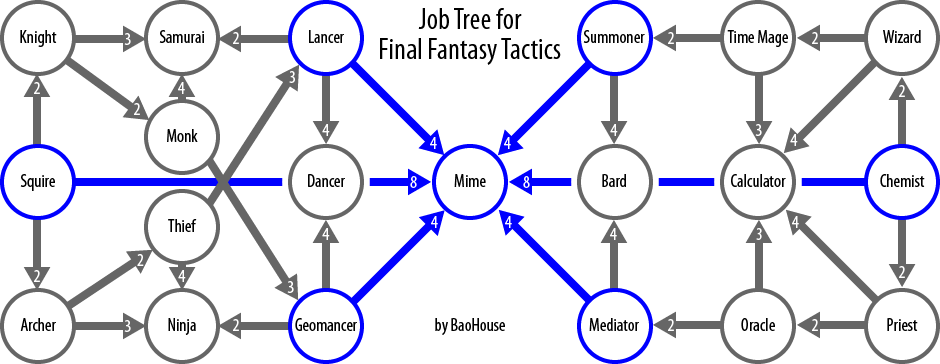 (From The Final Fantasy Wiki)
(From The Final Fantasy Wiki)
The player spends Job Points to unlock abilities. Most abilities cost between 100 and 400 JP, with others costing as little as 25 or as much at 1,000. In a typical battle a character will earn somewhere between 100 and 250 JP, which means that they’ll usually be able to unlock some ability each battle in the early stages of leveling up a Job. Later on it’ll be a few battles between ability unlocks.
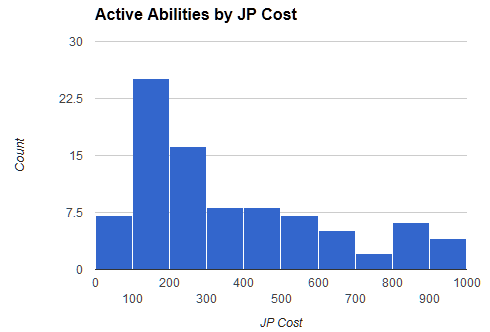
An interesting twist is that sometimes the player doesn’t need to pay JP to unlock abilities–there’s another way to acquire abilities! If any character is not resurrected within three turns of its death, it is replaced with a treasure box or a crystal. When a character moves on to a crystal, the player (or AI) gets the choice of regaining some HP and MP, or “inheriting” some randomly-picked abilities from the crystallized character. Inheriting abilities only works if the character picking up the crystal has unlocked the job associated with the skills in the crystal.
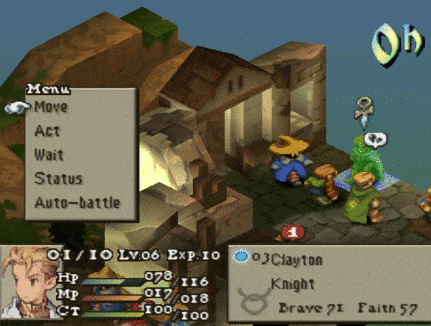 (My Knight saves over 1,000 JP by inheriting a defeated Knight’s crystal.)
(My Knight saves over 1,000 JP by inheriting a defeated Knight’s crystal.)
Though the Job system gives the player a lot of interesting options for building an efficient party that can annihilate enemies in any number of creative ways, the way that JP feeds into party-building as a reward system doesn’t work as well as it could. My primary complaint about the tuning of JP is that the player can easily go a battle or two without unlocking any interesting new abilities. One of the most fun things in my experience with the game is when I unlock and start using that awesome new ability I’d been planning to get and building towards. With somewhat variable and sometimes slow ability unlock pacing, that cycle of setting my eyes on a new ability I want and then actually being able to use it in combat can be unpleasantly stifled. At the other extreme, when the player can get crystals of the Jobs that they want, it can lead to a landslide of progression. This kind of uneven reward pacing may keep the player marginally more engaged than a steady drip, but the lulls are made worse in my experience by those times when it seems I’m unlocking far more abilities than I will want to use.
Now that we covered the systems behind character progression, we have sufficient knowledge to make a broader critique of the dynamics that emerge. Next in this series, I’ll be examining an aspect of playing Final Fantasy Tactics that prevents me from falling in love with the gameplay, and, I argue, prevents the gameplay from reaching its full potential: grinding.
 POV: PLAYER. DIFFICULTY 4. LEVEL 3 – 1
POV: PLAYER. DIFFICULTY 4. LEVEL 3 – 1
Final Fantasy Tactics has two progression schemes: One that causes core character stats to increase according to parameters defined by the Job the character has when they level up, and one that is used to buy skills within the Jobs that the character has access to.
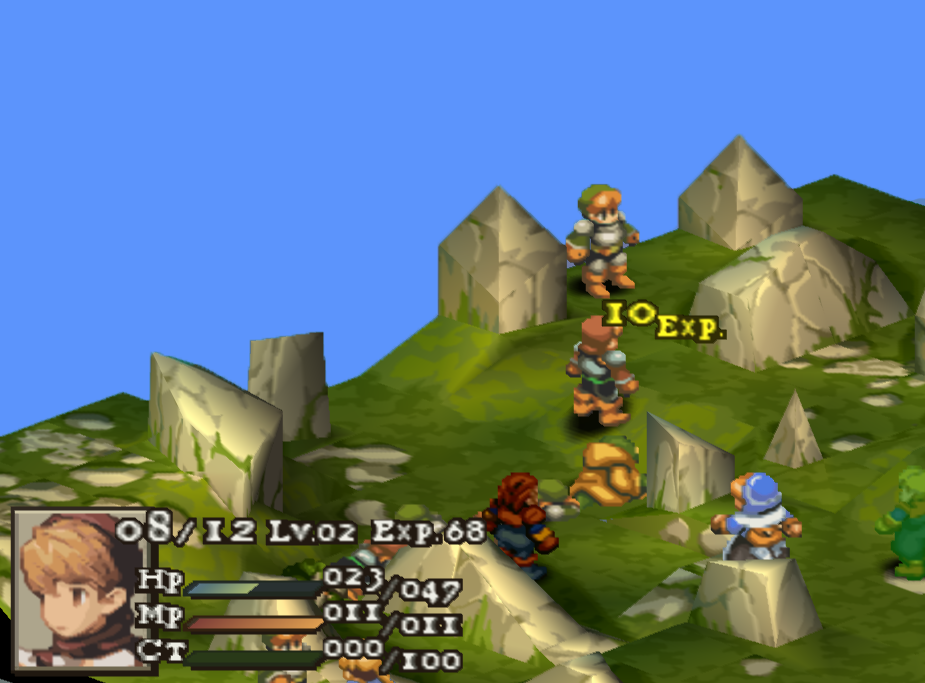
The article is about that first progression scheme: character levels.
A character levels up when they reach 100 XP, then the character’s XP resets to 0. XP is gained when a character uses an ability or attack successfully, either doing damage to HP or MP, adding or removing a status effect, or modifying some stat of a friend or foe.
The basic formula for XP gained from a successful action is 10 + (Target’s Level – Actor’s Level). Killing the target for the first time grants a bonus 10 XP. If a character is resurrected and then killed again, the second time the character is killed there is no kill bonus. Subsequent deaths incur penalties to XP granted to the killer for that action.
| Target’s __ Death | XP Modifier |
|---|---|
| 1st | +10 |
| 2nd | 0 |
| 3rd | -4 |
| 4th | -5 |
| 5th | -6 |
| 6th | -7 |
| More than 6 | -8 |
Example: The player’s level 5 Archer hits the opponent’s level 5 Knight with an attack. The Archer gains 10 + (5 – 5) +0 = 10 XP. If that archer were level 3, and killed the level 5 Knight for the first time with that attack, the archer would gain 10 + (5 – 3) + 10 = 22 XP. Now if that Knight were resurrected, and a level 7 Ninja came by and finished him off for a second time, that’d give the Ninja 10 + (5 – 7) + 0 = 8 XP.
Thus it takes at most ten successful actions against same-level targets to level up.
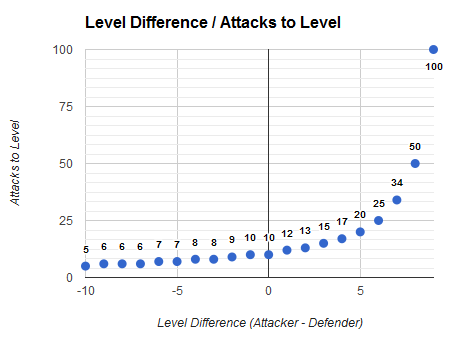
The player is seldom in a position where their characters will earn extra XP from fighting higher-level opponents, especially considering that the player can fight in some random encounters between story battles to overlevel for upcoming missions. In order for it to take one less attack to level up the attacking character must be two levels lower than the defender.
Typically there won’t be more than eight opponents and five player-controlled characters in a battle, and a character takes 3 to 5 successful attacks to kill (I’ll show the work behind this number in later articles). Half the friendly characters in a battle are likely to get 2 kills, so for those characters that’s a total of 8 attacks to level: 6 earn 10 XP and 2 earn 20 XP. Characters that mainly use status effect magic and are unlikely to deal sufficient damage to kill an enemy will take at least the full 10 successful actions to level. They’ll on average need several more actual attacks, because the success rates of status magic can be as low as 50-60% whereas physical and magical damaging attacks have much higher average success rates.
This scheme leads to a relatively swift pace of leveling up, and rewards the player with several level-ups per combat in typical battles.
So far we have the outline of a serviceable leveling system, consistent with other games in the genre, like Tactics Ogre and Fire Emblem. Stay tuned for more in-depth analysis on progression in Final Fantasy Tactics–next up is Job progression!
 POV: DESIGNER. DIFFICULTY 1. LEVEL 1 – 1
POV: DESIGNER. DIFFICULTY 1. LEVEL 1 – 1
In Statistically Speaking, It’s Probably a Good Game Tyler Sigman gives a primer on probability from a game design perspective. He covers some basic mathematical facts of probability, but also talks about common misunderstandings.
Mike says: Randomized elements are so common in games that this article is more than worth a read, even if you think you know all it might have to say. I learned a bit more by digging through wikipedia after being inspired by some of this piece, particularly the fleeting mention of Binomial Distributions.
Richard says: The “quiz time” questions are thought provoking and even got me to laugh a bit. And no, the math isn’t the funny part. The last two paragraphs on page 1 describes the role and challenge of a game designer well.
“It’s pretty common to hear designers debating or waxing poetic on the finer points of linear or non-linear storytelling, human psychology, control ergonomics, or the integration of non-interactive sequences; less often do you catch them mulling over the bare bones details of the hard sciences like calculus, physics, or statistics. ” ~ Tyler Sigman
I don’t know how common it is for designers to talk about “control ergonomics,” but I like the point Tyler makes. The math part of game design is one of the hardest aspects to discuss among players and designers.

 POV: DESIGNER. DIFFICULTY 3. LEVEL 2 – 1
POV: DESIGNER. DIFFICULTY 3. LEVEL 2 – 1
Host: Richard (KirbyKid) Terrell
Guests: Sanatana Mishra & Tim Dawson
Game: Assault Android Cactus
 POV: DESIGNER. DIFFICULTY 2. LEVEL 2-1
POV: DESIGNER. DIFFICULTY 2. LEVEL 2-1
Have you ever been afraid taking a closer look at a favorite and classic game might reveal that it isn’t as good as you remember? Have you wondered if your memories of a game are just a phantom, a collection of scattered thoughts you follow in an endless loop? Have you chased feelings of nostalgia trying to relive what once was? If so, then you probably can relate to the Ghosts in Pac-Man. For well-designed games, what makes them good back in the day is the same thing that makes them good today. Pac-Man’s fame is still recognized because of its polished, well-tuned gameplay. What makes Pac-Man great can be summed up like this:
Pac-Man is an action game that challenges players to move through a maze. The goal is to navigate through the twists and turns of the maze to consume each dot and Power Pellet. How you navigate is up to you: there are hundreds of ways to beat each maze. And where you need to go is easy to determine: Simply follow the trail. Playing Pac-Man would be a trivial challenge if it weren’t for the Ghosts. Avoiding, kiting, and turning the tables on the enemy Ghosts adds complexity and depth to the gameplay. The threat of running into a Ghost makes a simple pathing decision into a much more complicated one. Where you go, when you go, and why depends on the where the Ghosts are, how they’re moving, and how close Pac-Man is to Power Pellet.
A key factor in what makes Pac-Man so fun is clear feedback. With all the level and enemy elements clearly visible at a glance, the player has all the information needed to make well-informed decisions. Though Pac-Man only features a MOVE mechanic, players constantly make decisions about where and when to move by leveraging this clear feedback. Especially when players are under pressure because of the speed at which events unfold, having such good feedback keeps the Ghosts movement from feeling like frustrating ambushes from out of nowhere.
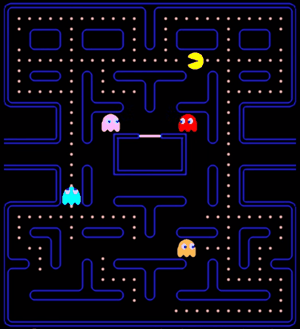 FROM YOUTUBE VIDEO HOW TO WIN AT PAC-MAN- PROPER ARCADE VERSION BY STEVEPIERS
FROM YOUTUBE VIDEO HOW TO WIN AT PAC-MAN- PROPER ARCADE VERSION BY STEVEPIERS
Perhaps the depth of Pac-Man gameplay can best be understood by considering how each aspect of the enemy Ghost elements makes the goal of eating all the dots and Power Pellet in the maze more difficult. Without Ghosts, the goal is easily obtained. Throw one Ghost in the maze, and crossing its path is generally the only thing a player would have to worry about. In fact, if the Ghost is constantly chasing the player, it stops becoming a threat as it will not be able to catch up to Pac-Man. One ghost is not enough. But throw in four Ghosts, and things get more interesting… at least initially. With a little maneuvering, the same problem exists. As long as the player can get all four Ghosts to follow in Pac-Man’s wake they will not be a threat.
The monotony of the chorale-and-run-away play strategy is shaken up by the Ghost AI personalities and AI modes.
 “Ghosts’ movement patterns in the “scatter” phase once they’ve reached their home corner.” Image from the amazaing Pac-Man Dossier by Jamey Pittman
“Ghosts’ movement patterns in the “scatter” phase once they’ve reached their home corner.” Image from the amazaing Pac-Man Dossier by Jamey Pittman  See the Ghost switch from chase to scatter From youtube video How to Win at Pac-Man- Proper Arcade Version by stevepiers
See the Ghost switch from chase to scatter From youtube video How to Win at Pac-Man- Proper Arcade Version by stevepiers
Each Ghost has a personality that determines how it moves through the maze. Yes, in general all the Ghosts appear to just follow Pac-Man around, but if we look closely only the red Ghost, “Blinky”, is completely dedicated to directly hunting Pac-Man. It always tries to close in on Pac-Man’s exact position. In contrast “Pinky” prefers to move into the space that is a few squares in front of where Pac-Man is facing. What’s interesting is players generally interpret Pinky’s unique AI personality as being non-confrontational and easily spooked. Put Blinky and Pinky in the maze together and they often work together to head Pac-Man off and pin him from both sides.
Ghost AI modes shake things up in a much more obvious way. Ghosts will switch between “chase” and “scatter” modes on a timer. They’ll spend most of their time in “chase” mode and brief periods where they’ll “scatter.” Even if the Ghosts are closing in for the kill, when the timer goes off the Ghosts will ignore Pac-Man and retreat to their respective home corner. So even if a player manages to string the Ghosts along, it will only last as long as the AI mode timer allows. When Pac-Man grabs an energizer Power Pellet the Ghosts switch to a frightened AI mode, in which they will reverse direction and choose random turns as they run away. Between the automatic, timer-based modes (chase, scatter) and the player-activated mode (frightened), the apparent dominant strategy of kiting the Ghosts is minimized in effectiveness and players have to adjust to the constantly changing and partially unpredictable game state.
Here are more nuances and wrinkles to Pac-Man’s design that increase the challenge for players aiming for high scores:
If you take all of these aspects into account, you can see how Pac-Man’s gameplay has enough challenge and complexity for players to spend years enjoying and mastering the game.
With relatively few mechanics, elements, and rules, Pac-Man achieves gameplay that is deep, challenging, and that dynamically changes with each play. Next in this article series, we’ll look at how Pac-Man’s design and gameplay hold up in the Google Doodle and the Google Map versions.